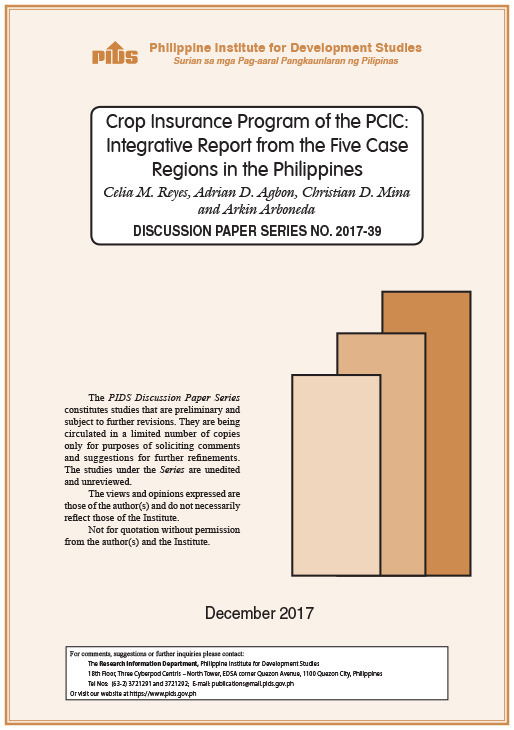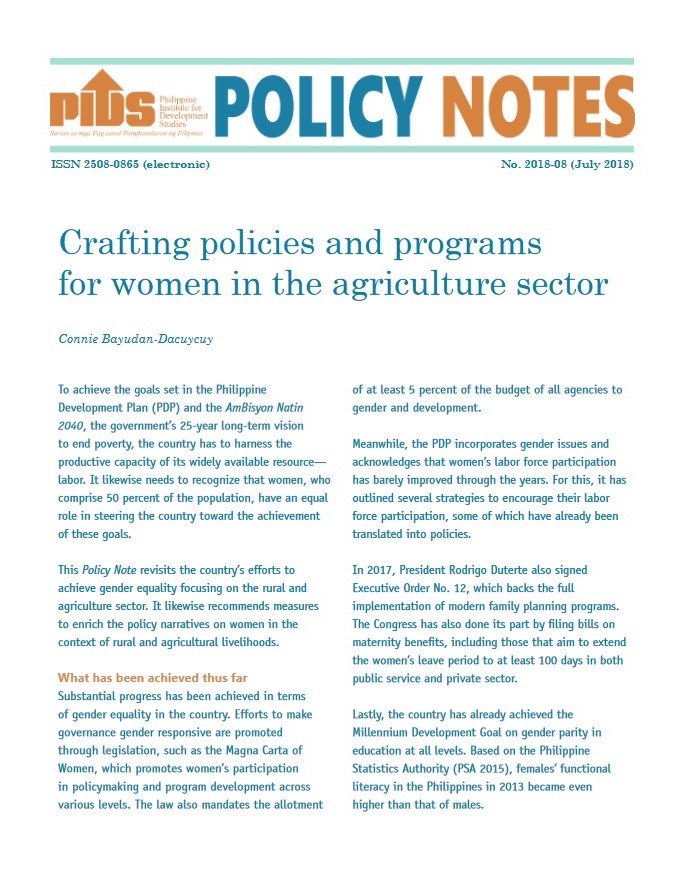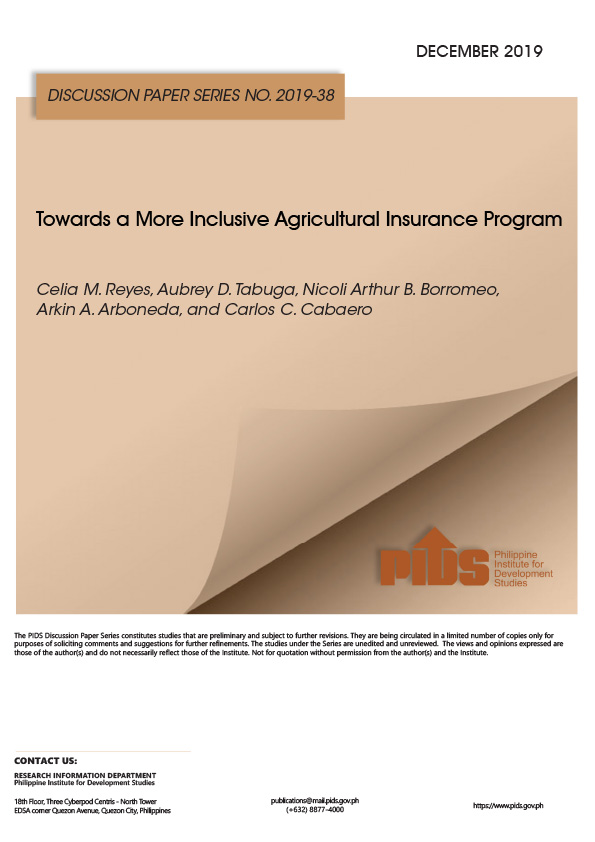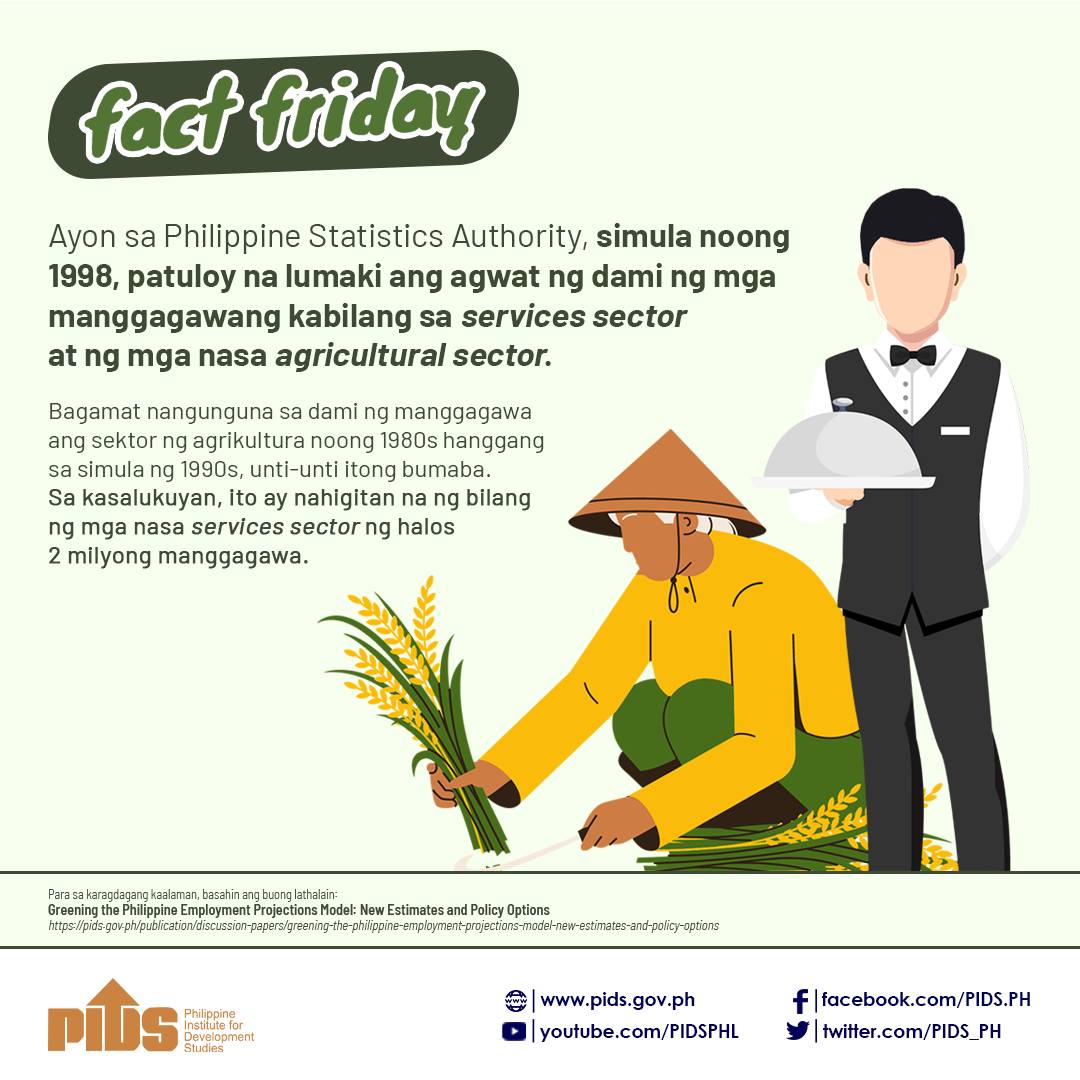Most of those who benefited from the government’s agricultural insurance program (AIP) are government agencies and big farm owners, rather than the small and marginalized farmers, according to the Philippine Institute for Development Studies (PIDS).
In the policy note, titled “Is the Agricultural Insurance Program of the Philippines serving the poor?”, former National Statistical Coordination Board (NSCB) Secretary-General Romulo A. Virola said government agencies, such as the Department of Agriculture (DA), have become “big” AIP beneficiaries, when it should be the small-scale Filipino farmers.
Virola said drastic decline in the penetration rate of AIP for palay farmers was observed in the nearly past three decades.
The penetration rate for palay had actually been much higher from 1988 to 1993, averaging about 10 percent,” he said.It had gone below 2 percent from 2000 to 2008, but rose to 10.2 percent in 2013 after the agrarian-reform beneficiaries [ARBs] received subsidized coverage,” he added. Meanwhile, corn farmers covered by the government’s AIP since 1987 have remained below the 2-percent level, according to Virola. “In the case of corn, this rate had never been above 2 percent from 1987 to 2012. In 2013 it was only 2.3 percent.
Virola noted that it seems that the design of the government’s AIP claims-processing protocols have some flaws, as some beneficiaries received “low” amount of insurance. For instance, a rice farmer in Cagayan Valley region only received P38. Likewise, nine of 13 regions had received rice-claim payments less than P200 from 2013 to 2014,” he said.
Some corn farmers were also insured for low amounts. Is this an indication of some flaws in the design of the AIP claims-processing protocols? A review of the claim-adjudication policies is definitely called for,” he added.
Virola recommended that the government should reform its AIP to a more marginalized farmers-centric program in order to contribute in alleviating the country’s poverty incidence.
Assuming the AIP will continue to be operated more as a social-insurance scheme rather than as a private-insurance scheme, clear policiesshould be formulated and support mechanisms should be put in place to target the coverage of the marginalized subsistence farmers, the underserved regions like Bicol region and ARMM, the borrowing farmers who should be provided with easy access to credit, and other groups like the Pantawid Pamilyang Pilipino Program beneficiaries,” he said.
The government should also focus its AIP toward the crop that most of the subsistence Filipino farmers are planting today, Virola suggested.The AIP started covering only palay and corn farmers. While the expansion of the AIP to cover other farmers and other product lines is to be expected, clear policies should be formulated to better guide the PCIC in targeting improvements in the AIP,” he said.
If most of the subsistence farmers are planting palay or corn, the target should focus on improving programs concentrating on these crops,” he added.Citing data from the PCIC, term insurance program (TIP) had the biggest share in terms of the amount of AIP insurance, accounting for 42 percent, Virola said.
This was followed by palay with 31 percent, HVCC with 13 percent and corn with 7 percent.TIP has substantially grown in share of the AIP coverage in recent years. This can be perceived as possibly competing unfairly with the private sector,” Virola said.
Virola added that there is also a need to redesign the premiums and premium subsidies by the government by “setting the premiums marginalized farmers need to pay as low as possible, regardless of farm location”.
This kind of premiums and premium design would provide the “largest” possible support for the marginalized subsistence farmers, he added.Virola said there have been big percentage increases in the gross premiums of more than 50 percent in the years 1982, 1985, 1991, 2008 and 2009.
Furthermore, a 176-percent jump in gross premiums happened in 2013, due to the premiums from/for the rice and corn farmers who were covered under the ARB program.
This was sustained by an 88-percent increase in 2014, but followed by a 5-percent decline in 2015.
The PCIC needs to analyze this reduction in gross premiums to understand whether it indicates the saturation of the targeted beneficiaries [i.e., it has covered practically all the beneficiaries it has targeted to cover given its resources], the declining government support for the AIP, or the stretched capacity of the PCIC to sustain the program,” he added.
Virola recommended that the PCIC charge the farmers only the net premiums based on the historical claims experience of the AIP, and the rest to be charged to subsidies from the government and lending institutions. “Another is to put a cap on the amount paid by the farmers, such as a certain percentage of the minimum wage,” he added.Virola also noted that there were regional disparities in the gross premiums being paid by Filipino farmers.
Such discrepancy could be disadvantageous to Filipino farmers situated in typhoon-phone areas, he added.
For example, borrowing farmers pay premiums ranging from 1.17 percent of the sum insured to 2.6 percent during the wet season, and from 0.56 percent to 2.33 percent during the dry season in low-risk areas.Meanwhile, borrowing farmers from high-risk areas pay from 3.5 percent to 7.79 percent during the wet season and from 1.69 percent to 6.99 percent during the dry season, according to Virola.
It should also be clarified whether there is a need for premium/premium subsidy differentials across regions and between low-risk areas and high-risk areas,” he said. “The existence of such differentials may disadvantage poor farmers located in typhoon-prone regions. The PCIC, an attached government-owned and -controlled corporation of the DA, is the implementing body of the government’s AIP.
It is mandated to provide insurance protection to farmers against losses of their crops and produce, as well as their livestock and farm-related equipment, arising from natural calamities or events beyond their control.
In the policy note, titled “Is the Agricultural Insurance Program of the Philippines serving the poor?”, former National Statistical Coordination Board (NSCB) Secretary-General Romulo A. Virola said government agencies, such as the Department of Agriculture (DA), have become “big” AIP beneficiaries, when it should be the small-scale Filipino farmers.
Virola said drastic decline in the penetration rate of AIP for palay farmers was observed in the nearly past three decades.
The penetration rate for palay had actually been much higher from 1988 to 1993, averaging about 10 percent,” he said.It had gone below 2 percent from 2000 to 2008, but rose to 10.2 percent in 2013 after the agrarian-reform beneficiaries [ARBs] received subsidized coverage,” he added. Meanwhile, corn farmers covered by the government’s AIP since 1987 have remained below the 2-percent level, according to Virola. “In the case of corn, this rate had never been above 2 percent from 1987 to 2012. In 2013 it was only 2.3 percent.
Virola noted that it seems that the design of the government’s AIP claims-processing protocols have some flaws, as some beneficiaries received “low” amount of insurance. For instance, a rice farmer in Cagayan Valley region only received P38. Likewise, nine of 13 regions had received rice-claim payments less than P200 from 2013 to 2014,” he said.
Some corn farmers were also insured for low amounts. Is this an indication of some flaws in the design of the AIP claims-processing protocols? A review of the claim-adjudication policies is definitely called for,” he added.
Virola recommended that the government should reform its AIP to a more marginalized farmers-centric program in order to contribute in alleviating the country’s poverty incidence.
Assuming the AIP will continue to be operated more as a social-insurance scheme rather than as a private-insurance scheme, clear policiesshould be formulated and support mechanisms should be put in place to target the coverage of the marginalized subsistence farmers, the underserved regions like Bicol region and ARMM, the borrowing farmers who should be provided with easy access to credit, and other groups like the Pantawid Pamilyang Pilipino Program beneficiaries,” he said.
The government should also focus its AIP toward the crop that most of the subsistence Filipino farmers are planting today, Virola suggested.The AIP started covering only palay and corn farmers. While the expansion of the AIP to cover other farmers and other product lines is to be expected, clear policies should be formulated to better guide the PCIC in targeting improvements in the AIP,” he said.
If most of the subsistence farmers are planting palay or corn, the target should focus on improving programs concentrating on these crops,” he added.Citing data from the PCIC, term insurance program (TIP) had the biggest share in terms of the amount of AIP insurance, accounting for 42 percent, Virola said.
This was followed by palay with 31 percent, HVCC with 13 percent and corn with 7 percent.TIP has substantially grown in share of the AIP coverage in recent years. This can be perceived as possibly competing unfairly with the private sector,” Virola said.
Virola added that there is also a need to redesign the premiums and premium subsidies by the government by “setting the premiums marginalized farmers need to pay as low as possible, regardless of farm location”.
This kind of premiums and premium design would provide the “largest” possible support for the marginalized subsistence farmers, he added.Virola said there have been big percentage increases in the gross premiums of more than 50 percent in the years 1982, 1985, 1991, 2008 and 2009.
Furthermore, a 176-percent jump in gross premiums happened in 2013, due to the premiums from/for the rice and corn farmers who were covered under the ARB program.
This was sustained by an 88-percent increase in 2014, but followed by a 5-percent decline in 2015.
The PCIC needs to analyze this reduction in gross premiums to understand whether it indicates the saturation of the targeted beneficiaries [i.e., it has covered practically all the beneficiaries it has targeted to cover given its resources], the declining government support for the AIP, or the stretched capacity of the PCIC to sustain the program,” he added.
Virola recommended that the PCIC charge the farmers only the net premiums based on the historical claims experience of the AIP, and the rest to be charged to subsidies from the government and lending institutions. “Another is to put a cap on the amount paid by the farmers, such as a certain percentage of the minimum wage,” he added.Virola also noted that there were regional disparities in the gross premiums being paid by Filipino farmers.
Such discrepancy could be disadvantageous to Filipino farmers situated in typhoon-phone areas, he added.
For example, borrowing farmers pay premiums ranging from 1.17 percent of the sum insured to 2.6 percent during the wet season, and from 0.56 percent to 2.33 percent during the dry season in low-risk areas.Meanwhile, borrowing farmers from high-risk areas pay from 3.5 percent to 7.79 percent during the wet season and from 1.69 percent to 6.99 percent during the dry season, according to Virola.
It should also be clarified whether there is a need for premium/premium subsidy differentials across regions and between low-risk areas and high-risk areas,” he said. “The existence of such differentials may disadvantage poor farmers located in typhoon-prone regions. The PCIC, an attached government-owned and -controlled corporation of the DA, is the implementing body of the government’s AIP.
It is mandated to provide insurance protection to farmers against losses of their crops and produce, as well as their livestock and farm-related equipment, arising from natural calamities or events beyond their control.







